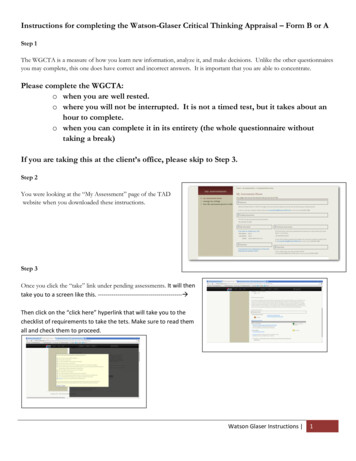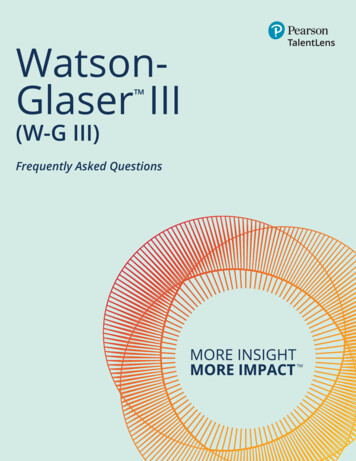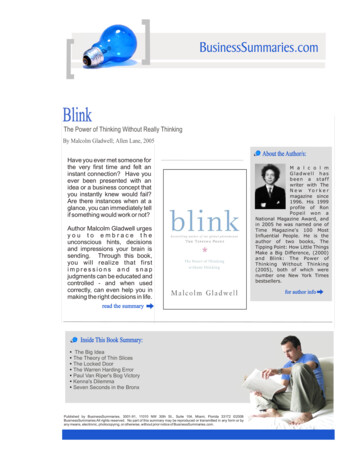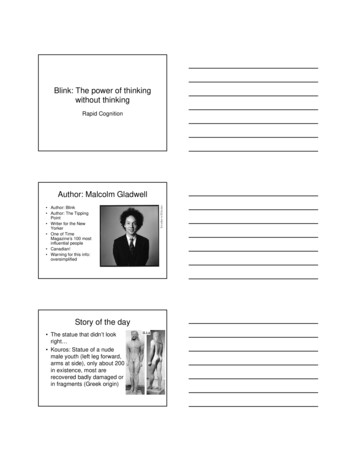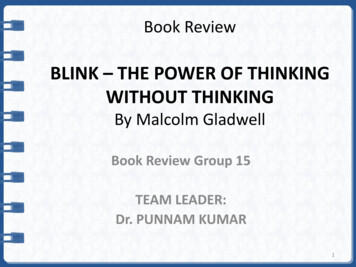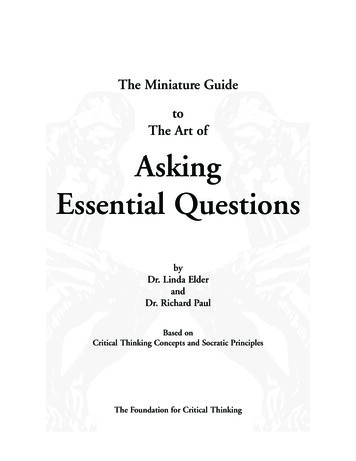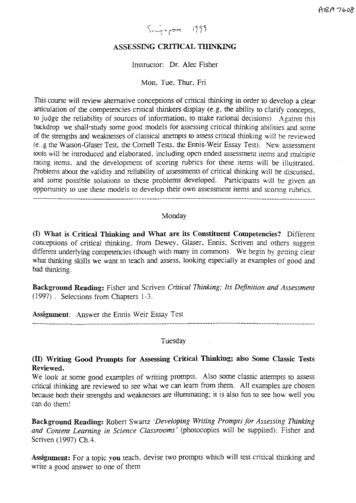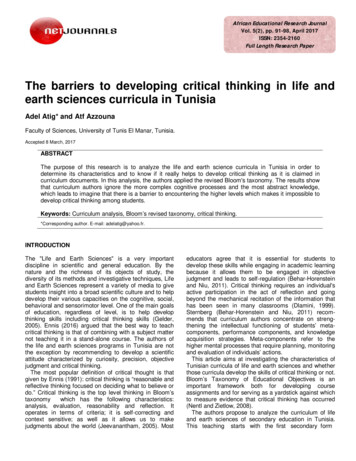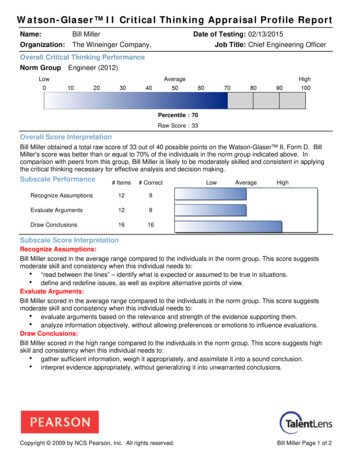
Transcription
Watson-Glaser II Critical Thinking Appraisal Profile ReportName:Organization:Bill MillerThe Wineinger Company,Date of Testing: 02/13/2015Job Title: Chief Engineering OfficerOverall Critical Thinking PerformanceNorm Group Engineer (2012)LowAverageHighPercentile : 70Raw Score : 33Overall Score InterpretationBill Miller obtained a total raw score of 33 out of 40 possible points on the Watson-Glaser II, Form D. BillMiller's score was better than or equal to 70% of the individuals in the norm group indicated above. Incomparison with peers from this group, Bill Miller is likely to be moderately skilled and consistent in applyingthe critical thinking necessary for effective analysis and decision making.Subscale Performance# Items# CorrectRecognize Assumptions129Evaluate Arguments128Draw Conclusions1616LowAverageHighSubscale Score InterpretationRecognize Assumptions:Bill Miller scored in the average range compared to the individuals in the norm group. This score suggestsmoderate skill and consistency when this individual needs to:“read between the lines” – identify what is expected or assumed to be true in situations.define and redefine issues, as well as explore alternative points of view.Evaluate Arguments:Bill Miller scored in the average range compared to the individuals in the norm group. This score suggestsmoderate skill and consistency when this individual needs to:evaluate arguments based on the relevance and strength of the evidence supporting them.analyze information objectively, without allowing preferences or emotions to influence evaluations.Draw Conclusions:Bill Miller scored in the high range compared to the individuals in the norm group. This score suggests highskill and consistency when this individual needs to:gather sufficient information, weigh it appropriately, and assimilate it into a sound conclusion.interpret evidence appropriately, without generalizing it into unwarranted conclusions.Herefor noreasonCopyright 2009 by NCS Pearson, Inc. All rights reserved.Bill Miller Page 1 of 2
Skills and Abilities Assessed by the Watson-Glaser II Critical Thinking AppraisalThe Watson-Glaser II Critical Thinking Appraisal is designed to measure select skills and abilities involvedin critical thinking. These include:Recognize Assumptions — Assumptions are statements that are assumed to be truein the absence of proof. Identifying them helps reveal information gaps and enrich perspectives on anissue. Assumptions can be unstated or directly stated. Being aware of these assumptions and directlyassessing their appropriateness to a situation improves the quality and comprehensiveness of criticalthinking.Evaluate Arguments — Arguments are assertions that are intended to persuade someone tobelieve or act a certain way. Evaluating arguments is the process of analyzing such assertionsobjectively and accurately. Analyzing arguments helps determine whether to believe something or notand how to respond accordingly. Evaluating arguments requires the ability to overcome a confirmationbias—the tendency to look for and agree with information that confirms prior beliefs. Emotion plays akey role in evaluating arguments as well—a high level of emotion can cloud objectivity and the abilityto accurately evaluate arguments.Draw Conclusions — Drawing conclusions consists of arriving at conclusions that logically followfrom the available evidence. It includes evaluating all relevant information before drawing a conclusion,judging the likelihood of different conclusions being correct, selecting the most appropriate conclusion,and avoiding overgeneralization beyond the evidence.Note. The Watson-Glaser II Critical Thinking Appraisal should never be used as the sole basis for making anemployment decision. For more information on best practices for using test scores in selection decisions, please consultthe Watson-Glaser II Critical Thinking Appraisal Manual, the Uniform Guidelines for Employee Selection Procedures,the Standards for Educational and Psychological Testing, and the Principles for the Validation and Use of PersonnelSelection Procedures.Herefor noreasonCopyright 2009 by NCS Pearson, Inc. All rights reserved.Bill Miller Page 2 of 2
TMWatson-Glaser IICritical Thinking AppraisalDEVELOPMENT REPORT.Bill Miller13 Feb 2015Form D
Copyright 2009 by NCS Pearson, Inc. All rights reserved.Bill Miller Page 2 of 15
Copyright 2009 by NCS Pearson, Inc. All rights reserved.Bill Miller Page 3 of 15
Copyright 2009 by NCS Pearson, Inc. All rights reserved.Bill Miller Page 4 of 15
Copyright 2009 by NCS Pearson, Inc. All rights reserved.Bill Miller Page 5 of 15
Copyright 2009 by NCS Pearson, Inc. All rights reserved.Bill Miller Page 6 of 15
Copyright 2009 by NCS Pearson, Inc. All rights reserved.Bill Miller Page 7 of 15
Copyright 2009 by NCS Pearson, Inc. All rights reserved.Bill Miller Page 8 of 15
Copyright 2009 by NCS Pearson, Inc. All rights reserved.Bill Miller Page 9 of 15
Copyright 2009 by NCS Pearson, Inc. All rights reserved.Bill Miller Page 10 of 15
Copyright 2009 by NCS Pearson, Inc. All rights reserved.Bill Miller Page 11 of 15
Copyright 2009 by NCS Pearson, Inc. All rights reserved.Bill Miller Page 12 of 15
Copyright 2009 by NCS Pearson, Inc. All rights reserved.Bill Miller Page 13 of 15
Copyright 2009 by NCS Pearson, Inc. All rights reserved.Bill Miller Page 14 of 15
Copyright 2009 by NCS Pearson, Inc. All rights reserved.Bill Miller Page 15 of 15
Watson-Glaser II Critical Thinking Appraisal Profile Report. Overall Critical Thinking Performance. Bill Miller obtained a total raw score of 33 out of 40 possible points on the Watson-Glaser II, Form D. Bill Miller's score was better than or equal to 70% of the individuals in the norm group indicated above.

